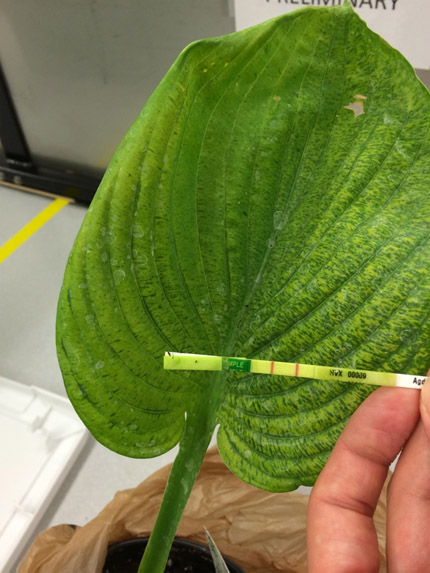Issue 6, June 1, 2015
Hosta Virus X
Take a tour of any shade garden, especially mine, and you will likely find an extensive collection of hostas. Hostas are one of the most popular herbaceous ornamentals; available in seemingly endless varieties of colors, patterns, sizes, and leaf shapes. Though considered mostly problem free, hostas are hosts to a number of potential pests. Hosta Virus X (HVX) continues to be one of the most important hosta diseases. In the past month alone, I observed two garden centers offering HVX infected hostas for sale. Thankfully, both garden centers quickly removed the infected plants from inventory after I pointed out the disease. Symptoms of HVX can be quite difficult to recognize. As a result, many other garden centers and retailers may unknowingly be selling HVX infected plants.
As with most viruses, HVX will not kill hosta; however it can cause a number of non-characteristic symptoms to appear on the host. Symptoms are usually consistent between plants of the same cultivar, but vary greatly between different cultivars. HVX often results in a change of leaf pigmentation to an either lighter or darker color. Color changes appear as mosaic, mottled, circular or “ink-bleed” (localized discoloration along the leaf veins) patterns. Other general HVX symptoms include: stunting, puckering, distortion, twisting, and necrosis. In general, avoid hosta's with features that vary significantly from those known to be normal for healthy plants of that cultivar. Not all HVX infected plants display symptoms. Infected plants may grow several years before displaying symptoms, while others never display symptoms at all. This means that seemingly healthy plants located next to HVX infected hostas may be infected as well.

Sum and Substance Hosta infected with Hosta Virus X. Confirmed using and ImmunoStrip. A healthy, normal Sum and Substance leaf should be entirely light green.
HVX is transmitted from plant to plant through physical or mechanical means. It is primarily spread during the propagation of infected plants. Fortunately, most reputable nurseries screen parent plants for pathogens prior to propagation. Secondary transmission occurs when HVX infected sap is transmitted to healthy, susceptible hostas by contaminated cutting tools and/or hands. The time of year may play a role in a plant's susceptibility to HVX. Some observations suggest HVX is most easily spread during spring months when hostas are actively growing and is most difficult to spread after bloom.
The following practices are recommended for Hosta Virus X management.
- Avoid introducing infected plants by purchasing from reputable sources.
- Avoid Spreading HVX within the landscape
- Transplant and divide hostas in the fall or after they bloom.
- Clean and sanitize tools when working with hostas, especially as you move between plants.
- Have suspected HVX plants diagnosed by a plant diagnostic laboratory.
- No chemical treatments are available. HVX infected plants should be removed immediately and destroyed.
(Travis Cleveland)
Author:
Travis Cleveland